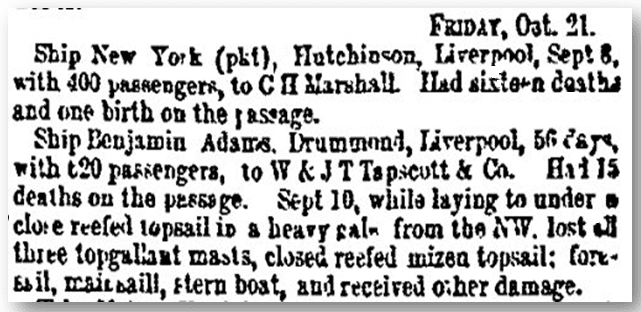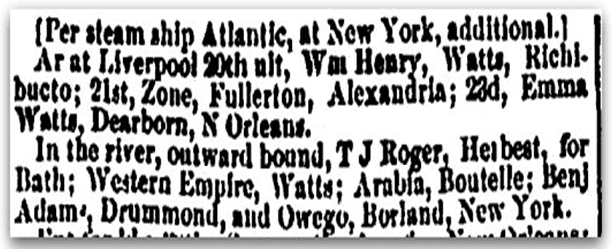Newspapers are pivotal for learning about your ancestor’s voyage to America. To find out more, search GenealogyBank for newspaper articles about the ship itself.
Genealogists usually find the name of the ship from family stories passed down over the generations, naturalization records, or from the passenger lists that are now widely available online. Once you know the name of the ship, search for newspaper articles that tracked the ship from overseas to America.
Newspapers routinely reported on ship movements because shipping had a direct impact on business and the economy.
Here’s what I found about my ancestor William Kemp’s trip to America onboard the ship Benjamin Adams. One article told me that his ship left Liverpool, England, on 24 August 1853.
Digging deeper I found that this was a tough trip.
This Weekly Herald article tells me that the voyage took 56 days with 620 passengers on board. That’s a lot of passengers.

Fifteen of them died during the voyage.
Wow. That’s incredible. Making the trip to America then was not easy.
More details: The article says that a few weeks into the trip, on 10 September 1853, the ship was hit by a storm suffering major damage:
“…while laying to under a close reefed topsail in a heavy gale from the NW, lost all three topgallant masts, closed reefed mizen [sic] topsail, foresail, mainsail, stern boat, and received other damage.”
Looking on the Internet I found a diary of Rasmus Neilsen who traveled to America on the same ship just a few months after William Kemp did. According to his diary they boarded the ship on Sunday, 22 January 1854. Their family is fortunate to still have a copy of his journal that records the story of their trip to America.
Wow.
This diary gives interesting details about his trip:
“We have good accommodations and good beds. We got our provisions: 2½ pounds white bread, oat meal, wheat meal, tea, sugar, salt – more than we need – and 3 gallons water.”
I assume that this was similar to William’s experience.
Five days later on Friday, 27 January 1854, he records they were:
“…towed out of harbor by a tug about two miles and lay there… We are waiting here to sail and hope the wind will soon blow from the east. Myself and wife and all five children are all well. Thank the Lord there is no sickness on board.”
(Source is: Manuscript Number 6006 (Typescript), pp. 109 in the Church Historical Department Archives.)
That’s interesting.
They boarded the ship and were towed from the pier waiting for the right wind so they could set sail.
They moved by wind power.
Newspapers reported on that same process when William was waiting to set sail.
Here is the report that the ship Benjamin Adams had moved from the dock and into the Mersey River ready to head outbound – waiting to move up the river with the aid of a tugboat to direct it safely to the open ocean.

Rasmus Neilsen recorded that:
“On Sunday morning we passed a large cutter drifting without men or sails. It had been lost in the storm Saturday night. It looked awful to see the water washing over it, and the sails and rigging hanging in the water. Who went down with it, the Lord only knows.”
Given the storm damage the Benjamin Adams experienced just months earlier during William’s voyage, it must have been riveting, while they were at sea, to come close enough to see another ship so damaged that it was abandoned and adrift on the open ocean.
Genealogy Tip: You can do this. Dig into old newspaper accounts and preserved diaries to learn more about your ancestor’s trip to America and the experience of other emigrants as they made the trip on the same ship.
